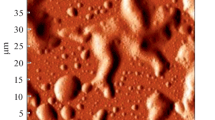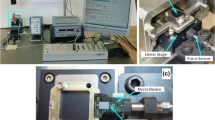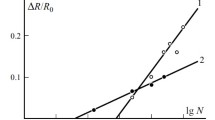Abstract
Polyimide films are being used extensively in first and second level microelec-tronic packages. Despite their many advantages, the tendency of polyimide films to absorb moisture can pose serious reliability problems such as corrosion, internal shorts, delamination, loss in dimensional stability, and a reduction in mechanical performance. This paper presents the results of an investigation of the effects of moisture upon stress relaxation in Kapton#x00AE; polyimide films. Three relaxation frames were designed and built so that they could be placed side by side within an environmental chamber which controlled both temperature and relative humidity. Stress relaxation experiments were then conducted in triplicate at various combinations of temperature and relative humidity and the relaxation modulus was determined as a function of time, temperature, and moisture concentration. While the relaxation modulus was found to decrease with increasing temperature and moisture concentration, this plasticizing effect could not be described by the simplifying assumption of time-temperature-moisture superposition except for those results obtained at or below 50% relative humidity. Application of the time-temperature superposition principle to the results obtained at relative humidities higher than 50% produced several distinct master curves at constant moisture concentration. These curves had fundamentally different shapes which could not be superimposed by rigid horizontal shifting.
Similar content being viewed by others
References
R.D. Rossi, Hybrid Circuit Techn. 6 (9), 35 (1989).
A.W. Lin, IEEE Trans. Components, Hybrids, and Manufacturing Techn. 13, 203 (1990).
M. Kochi, I. Mita and R. Yokota, Polymer Eng. and Sci. 24, 1021 (1984).
M. Kochi et al., J. Polymer Sci. Polymer Physics Ed. 28,2463 (1990).
S. Numata et al., Recent Advances in Polyimide Science and Technology, eds. W.D. Weber and M.R. Gupta, (New York: Society of Plastics Engineers, 1987), p. 164.
C.E. Sroog, Polyimides, ed. D. Wilson et al., (New York: Chapman and Hall, 1990).
R.D. Rossi and P.D. Machiesky, Solid State Techn. 33 (2), SI (1990).
M. Ree et al., Polymer Eng. and Sci. 32 (12), 924 (1992).
R.A. Pike, J.P. Pinto and CM. Brunette, Recent Advances in Polyirnide Science and Technology, ed. W.D. Weber and M.R. Gupta, (New York: Society of Plastics Engineers, 1987), p. 92.
Anon., Kapton® Summary of Properties, DuPont, Publication E-93189, Wilmington, DE., 1988.
B.D. Harper and J.M. Rao, J. Electron. Packaging 116, 317 (1994).
T.L. Smith and C.S. Kim, Materials Science of High Temperature Polymers for Microelectronics, ed. D.L. Grubb et al., (Pittsburgh, PA: Mater. Res. Soc, 1991), p. 219.
B.D. Harper and V. Sura, Time-Dependent Failure of Polymers: Experimental Studies, ed. V.H. Kenner, (ASME AMD- 155, 1992), p. 5.
B.D. Harper and V. Sura, Fracture and Damage, ed., A. Nagar, (ASME AD-27,1992), p. 119.
V.H. Kenner et al., Development of an Electronic Packaging Materials Database, (SRC Final Report, SRC Contract No. 93-MJ-322, Semiconductor Research Corporation, 1994).
F.W. Crossman, R.E. Mauri and N.T. Warren, Advanced CompositeMaterials-Environmental Effects,(ASTM STP658, 1978), p. 205.
W.G. Knauss and V.H. Kenner, J. Appl. Phys. 51 (10), 5131 (1980).
D.L. Flaggs and F.W. Crossman, J. Comp. Mater. 15, 21 (1981).
I. Emri, and V. Pavšek, Mater. Forum 16, 123 (1992).
B.D. Harper and Y. Weitsman, J. Rheology 29 (1), 49 (1985).
R.A. Schapery, Polymer Eng. and Sci. 9 (4), 295 (1969).
J.D. Ferry, Viscoelastic Properties of Polymers, 3rd.ed., (New York: John Wiley and Sons, 1980).
R. Subramanian et al., Proc. Materials Science of High Temperature Polumers Svmposium, eds. D.T. Grubb et al., (Pittsburgh, PA: Mater. Res. Soc, 1991), p. 147.
E. Sacher and J.R. Susko, J. Appl. Polymer Sci. 23, 2355 (1979).
E. Sacher and J.R. Susko, J. Appl. Polvmer Sci. 26, 679 (1981).
S.F. Popelar, C.H. Popelar and V.H. Kenner, Advances in Electronic Packaging, eds. W.T. Chen and H. Abel, 2, (1992), p. 619.
Author information
Authors and Affiliations
Rights and permissions
About this article
Cite this article
Harper, B.D., Rao, J.M., Kenner, V.H. et al. Hygrothermal effects upon stress relaxation in a polyimide film. J. Electron. Mater. 26, 798–804 (1997). https://doi.org/10.1007/s11664-997-0254-x
Received:
Revised:
Issue Date:
DOI: https://doi.org/10.1007/s11664-997-0254-x




